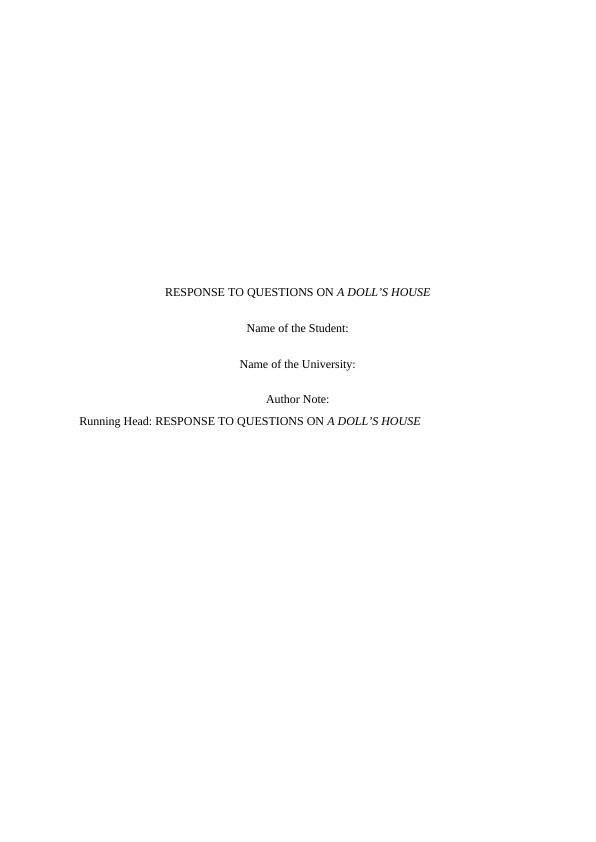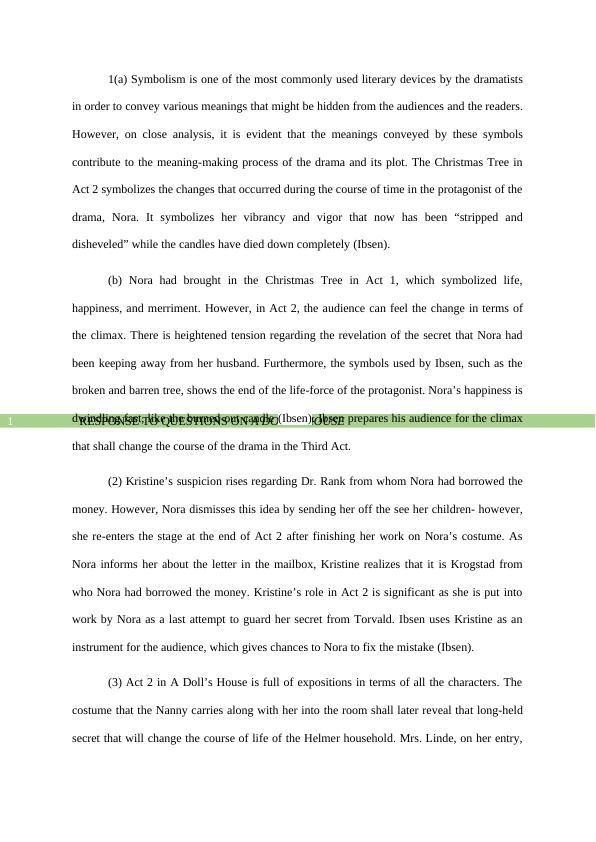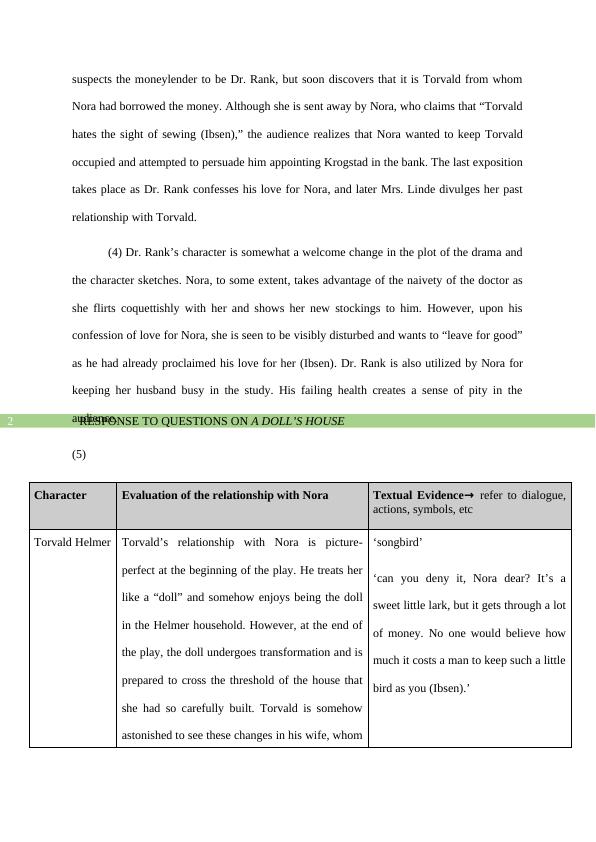Response to Questions on a Doll’s House
Added on 2022-08-24
7 Pages1467 Words26 Views
Running Head: RESPONSE TO QUESTIONS ON A DOLL’S HOUSE
RESPONSE TO QUESTIONS ON A DOLL’S HOUSE
Name of the Student:
Name of the University:
Author Note:
RESPONSE TO QUESTIONS ON A DOLL’S HOUSE
Name of the Student:
Name of the University:
Author Note:

RESPONSE TO QUESTIONS ON A DOLL’S HOUSE1
1(a) Symbolism is one of the most commonly used literary devices by the dramatists
in order to convey various meanings that might be hidden from the audiences and the readers.
However, on close analysis, it is evident that the meanings conveyed by these symbols
contribute to the meaning-making process of the drama and its plot. The Christmas Tree in
Act 2 symbolizes the changes that occurred during the course of time in the protagonist of the
drama, Nora. It symbolizes her vibrancy and vigor that now has been “stripped and
disheveled” while the candles have died down completely (Ibsen).
(b) Nora had brought in the Christmas Tree in Act 1, which symbolized life,
happiness, and merriment. However, in Act 2, the audience can feel the change in terms of
the climax. There is heightened tension regarding the revelation of the secret that Nora had
been keeping away from her husband. Furthermore, the symbols used by Ibsen, such as the
broken and barren tree, shows the end of the life-force of the protagonist. Nora’s happiness is
dwindling fast, like the burned-out candle (Ibsen). Ibsen prepares his audience for the climax
that shall change the course of the drama in the Third Act.
(2) Kristine’s suspicion rises regarding Dr. Rank from whom Nora had borrowed the
money. However, Nora dismisses this idea by sending her off the see her children- however,
she re-enters the stage at the end of Act 2 after finishing her work on Nora’s costume. As
Nora informs her about the letter in the mailbox, Kristine realizes that it is Krogstad from
who Nora had borrowed the money. Kristine’s role in Act 2 is significant as she is put into
work by Nora as a last attempt to guard her secret from Torvald. Ibsen uses Kristine as an
instrument for the audience, which gives chances to Nora to fix the mistake (Ibsen).
(3) Act 2 in A Doll’s House is full of expositions in terms of all the characters. The
costume that the Nanny carries along with her into the room shall later reveal that long-held
secret that will change the course of life of the Helmer household. Mrs. Linde, on her entry,
1(a) Symbolism is one of the most commonly used literary devices by the dramatists
in order to convey various meanings that might be hidden from the audiences and the readers.
However, on close analysis, it is evident that the meanings conveyed by these symbols
contribute to the meaning-making process of the drama and its plot. The Christmas Tree in
Act 2 symbolizes the changes that occurred during the course of time in the protagonist of the
drama, Nora. It symbolizes her vibrancy and vigor that now has been “stripped and
disheveled” while the candles have died down completely (Ibsen).
(b) Nora had brought in the Christmas Tree in Act 1, which symbolized life,
happiness, and merriment. However, in Act 2, the audience can feel the change in terms of
the climax. There is heightened tension regarding the revelation of the secret that Nora had
been keeping away from her husband. Furthermore, the symbols used by Ibsen, such as the
broken and barren tree, shows the end of the life-force of the protagonist. Nora’s happiness is
dwindling fast, like the burned-out candle (Ibsen). Ibsen prepares his audience for the climax
that shall change the course of the drama in the Third Act.
(2) Kristine’s suspicion rises regarding Dr. Rank from whom Nora had borrowed the
money. However, Nora dismisses this idea by sending her off the see her children- however,
she re-enters the stage at the end of Act 2 after finishing her work on Nora’s costume. As
Nora informs her about the letter in the mailbox, Kristine realizes that it is Krogstad from
who Nora had borrowed the money. Kristine’s role in Act 2 is significant as she is put into
work by Nora as a last attempt to guard her secret from Torvald. Ibsen uses Kristine as an
instrument for the audience, which gives chances to Nora to fix the mistake (Ibsen).
(3) Act 2 in A Doll’s House is full of expositions in terms of all the characters. The
costume that the Nanny carries along with her into the room shall later reveal that long-held
secret that will change the course of life of the Helmer household. Mrs. Linde, on her entry,

RESPONSE TO QUESTIONS ON A DOLL’S HOUSE2
suspects the moneylender to be Dr. Rank, but soon discovers that it is Torvald from whom
Nora had borrowed the money. Although she is sent away by Nora, who claims that “Torvald
hates the sight of sewing (Ibsen),” the audience realizes that Nora wanted to keep Torvald
occupied and attempted to persuade him appointing Krogstad in the bank. The last exposition
takes place as Dr. Rank confesses his love for Nora, and later Mrs. Linde divulges her past
relationship with Torvald.
(4) Dr. Rank’s character is somewhat a welcome change in the plot of the drama and
the character sketches. Nora, to some extent, takes advantage of the naivety of the doctor as
she flirts coquettishly with her and shows her new stockings to him. However, upon his
confession of love for Nora, she is seen to be visibly disturbed and wants to “leave for good”
as he had already proclaimed his love for her (Ibsen). Dr. Rank is also utilized by Nora for
keeping her husband busy in the study. His failing health creates a sense of pity in the
audience.
(5)
Character Evaluation of the relationship with Nora Textual Evidence→ refer to dialogue,
actions, symbols, etc
Torvald Helmer Torvald’s relationship with Nora is picture-
perfect at the beginning of the play. He treats her
like a “doll” and somehow enjoys being the doll
in the Helmer household. However, at the end of
the play, the doll undergoes transformation and is
prepared to cross the threshold of the house that
she had so carefully built. Torvald is somehow
astonished to see these changes in his wife, whom
‘songbird’
‘can you deny it, Nora dear? It’s a
sweet little lark, but it gets through a lot
of money. No one would believe how
much it costs a man to keep such a little
bird as you (Ibsen).’
suspects the moneylender to be Dr. Rank, but soon discovers that it is Torvald from whom
Nora had borrowed the money. Although she is sent away by Nora, who claims that “Torvald
hates the sight of sewing (Ibsen),” the audience realizes that Nora wanted to keep Torvald
occupied and attempted to persuade him appointing Krogstad in the bank. The last exposition
takes place as Dr. Rank confesses his love for Nora, and later Mrs. Linde divulges her past
relationship with Torvald.
(4) Dr. Rank’s character is somewhat a welcome change in the plot of the drama and
the character sketches. Nora, to some extent, takes advantage of the naivety of the doctor as
she flirts coquettishly with her and shows her new stockings to him. However, upon his
confession of love for Nora, she is seen to be visibly disturbed and wants to “leave for good”
as he had already proclaimed his love for her (Ibsen). Dr. Rank is also utilized by Nora for
keeping her husband busy in the study. His failing health creates a sense of pity in the
audience.
(5)
Character Evaluation of the relationship with Nora Textual Evidence→ refer to dialogue,
actions, symbols, etc
Torvald Helmer Torvald’s relationship with Nora is picture-
perfect at the beginning of the play. He treats her
like a “doll” and somehow enjoys being the doll
in the Helmer household. However, at the end of
the play, the doll undergoes transformation and is
prepared to cross the threshold of the house that
she had so carefully built. Torvald is somehow
astonished to see these changes in his wife, whom
‘songbird’
‘can you deny it, Nora dear? It’s a
sweet little lark, but it gets through a lot
of money. No one would believe how
much it costs a man to keep such a little
bird as you (Ibsen).’

End of preview
Want to access all the pages? Upload your documents or become a member.
Related Documents
Symbolism used in A Doll’s Houselg...
|4
|722
|14
Gender Roles in A Doll's House - Analysis and Discussionlg...
|8
|2482
|402
A Doll’s House | Story Analysislg...
|5
|810
|15
Character Assessment- A Doll's House | Assignmentlg...
|5
|939
|16
A Doll's House: A Modern Adaptationlg...
|5
|1479
|267
